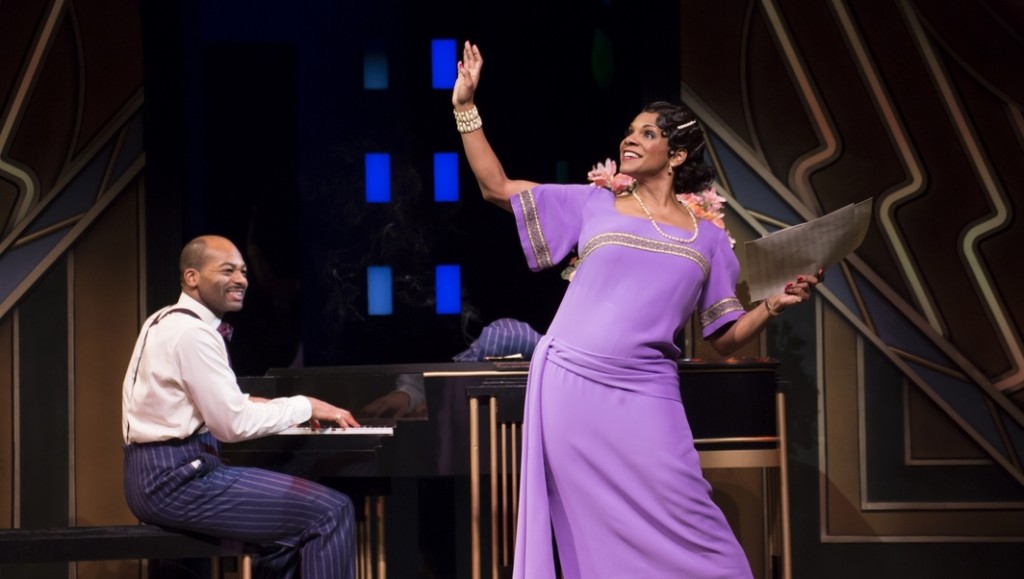To See or Not to See: Shuffle Along

Shuffle Along, or, the Making of the Musical Sensation of 1921 and All That Followed is a perfectly imperfect addition to this Broadway season. Though burdened with an uneven book, the production is made memorable by its energetic choreography, brilliant cast, and compelling history lesson. It brings together some of the brightest talents on Broadway to tell the story of the making of one of the most significant, though overlooked, productions in American history: the titular Shuffle Along, which premiered in 1921.
At first glance, the new Shuffle Along appears like a run-of-the-mill backstage musical. Four entertainers team up to produce a new musical for Broadway: writers F.E. Miller (Brian Stokes Mitchell) and Aubrey Lyles (Billy Porter) and composers Noble Sissle (Joshua Henry) and Eubie Blake (Brandon Victor Dixon), all of whom are historical figures. The show follows the creation, success, and demise of the original Shuffle Along, the musical they ultimately put together, tracing its trail of success from small-town venues to big-city music halls. Along the way, we meet divas, down-and-out dancers, and shifty producers.
So, what’s so special about the original Shuffle Along? Why write a show about a 1920s musical that most people haven’t heard of? Because the original Shuffle Along was an unprecedented Broadway hit that blazed a trail. It featured an all-black cast and a new kind of Broadway score. In other words, Shuffle Along was the Hamilton of its day. Just as Hamilton has brought hip-hop to Broadway, the original Shuffle Along brought jazz to the Great White Way. It introduced several important American standards, such as “I’m Just Wild about Harry” and “Love Will Find a Way.” The original show was also a career springboard for a number of legendary performers, like Josephine Baker and Paul Robeson.
Equally notable is the fact that Shuffle Along joins a number of historically-minded shows this season that engage with race in America– the Oscars may have been “so white,” but Broadway this year is anything but. Hamilton, The Color Purple, and Shuffle Along all approach the issue of America’s complicated racial past differently. Hamilton, for one, uses a multi-racial cast to tell the ultimate Dead White Guy story. Indeed, as one historian insightfully pointed out, though we can applaud Hamilton for its multi-racial casting, the musical more or less refuses to seriously engage with questions of slavery and race, questions that shaped and overshadowed the making of Hamilton’s America. (These issues did touch Alexander Hamilton himself: despite the musical’s emphasis on Hamilton’s anti-slavery beliefs, the fact remains that part of the reason the Schuyler Sisters were so wealthy was because, like Thomas Jefferson, their family didn’t pay for labor.) In some ways, then, The Color Purple and Shuffle Along correct Hamilton‘s weakness by confronting a history that the Pulitzer Prize-winner downplays– these shows tell stories, not about a white Founding Father, but about everyday black men and women.
Indeed, George C. Wolfe‘s book is a bold and sophisticated riff on America’s racial past. In remembering the original Shuffle Along and its significance, the new Shuffle Along proves that black lives and stories matter. After all, the creative team and performers who made the original Shuffle Along could never have been an Alexander Hamilton, since they were boxed in by an America that saw only the color of their skin. In one of the most uncomfortable and necessary moments at the beginning of the show, actors-turned-writers F.E. Miller and Aubrey Lyles, both of whom are black, sit side-by-side and darken their faces with make-up before performing on stage. Miller and Lyles, we learn, got their start in the entertainment industry as successful blackface performers. In other words, as black actors, they could only perform an unrealistic caricature of themselves, playing to a racialized stereotype that sought to keep down and dehumanize black Americans. The struggle to break free of those stereotypes is at the heart of the new musical. In an inspired moment, for example, Miller, Lyles, Sissle, and Blake humanize black characters in their show by directing the two lovers to touch one another during a romantic duet. The simple act of touching was a dramatic, humanizing expression of tenderness and affection– and doing it onstage dangerously defied the comedic, dim-witted, and emotionally shallow stereotypes that blackface caricatures reinforced. The show also elegantly inverts this historical problem of racial representation: one white actor (an engaging Brooks Ashmanskas) plays all of the white characters, as if to reduce the variety of white human beings down to a single body and person.
Yet, despite its brilliance and depth, Wolfe’s book is also uneven. The first act is much stronger than the second, even though it seems like a throwback. Like a 1920s revue, it feels like a series of stitched-together musical numbers; the story is in service of the music, not the other way around. But, it has enough life to dazzle the audience. The second act, which gets deeper into the struggles of the main characters and the dissolution of the four-man partnership, feels disjointed and loses a lot of the punch and power that propel the first act.
Happily, some of the production’s other aspects are flawless. Wolfe’s directorial vision is unified and focused. His recreation of the performative style of the 1920s is spot-on. Savion Glover proves, yet again, that he is a genius of movement, and his choreography is consistently jaw-dropping– make no mistake, this is the best dancing on Broadway. In one memorable moment among many, the dancers become a train, tap-dancing their way across Pennsylvania with chaotic precision. (In fact, the ensemble’s frenetic feet probably could ignite a fire under the right conditions.) Ann Roth‘s gorgeous costumes are elegant eye candy.
The uneven production was further elevated by the performance of its brilliant cast. Joshua Henry’s soulful Noble Sissle marches ever forward, even as he is haunted by inherited ambition and expectations. Billy Porter’s Aubrey Lyles is a bombastic and troubled showman who simmers with the rage of marginalization. Brian Stokes Mitchell’s F.E. Miller is a calming, dignified voice of moral authority and paternal responsibility. His rich baritone is gorgeously on display when, like a preacher lifting up the souls of his congregation, he leads the downtrodden, broke company in a stirring a cappella rendition of “Swing Along.” Finally, in a role that earned him a Tony nomination (and curiously the only acting nomination for the production), Brandon Victor Dixon’s Eubie Blake is playful as he reveals flashes of gentle genius.
But Queen Audra McDonald outshines them all. Playing the diva role (Lottie Gee), she proves she is a triple-threat, as she acts and tap dances as well as she can vocally slip and slide around the jazzy score. Her Lottie is deeper than a superficial diva, and she gives her a robust conscience, tender vulnerability, and sharp intelligence. That Ms. McDonald’s name does not appear on the list of Tony nominees is a real disappointment.
In one of the show’s final scenes, a wealthy white philanthropist-producer corners Miller, Lyles, Noble, and Sissle in a club and dismisses their success. “No one will remember you,” he sneers. George C. Wolfe’s Shuffle Along proves the opposite. This is a story and a production worth remembering.
Photo Credit: Julieta Cervantes


Discussion about this post